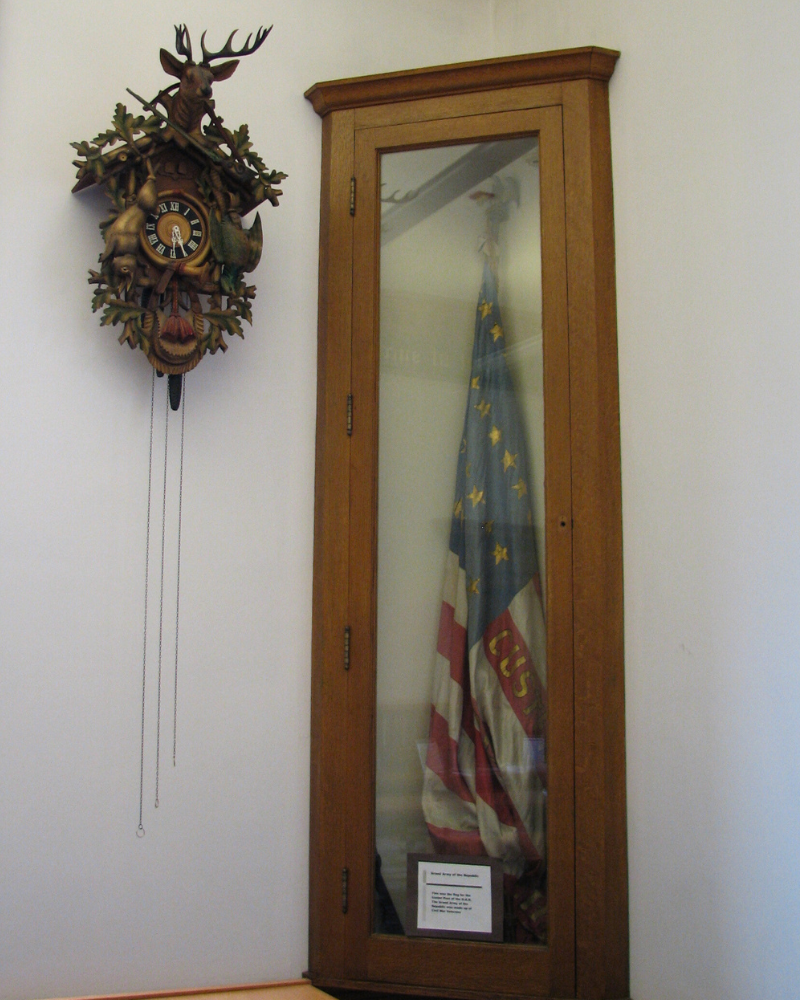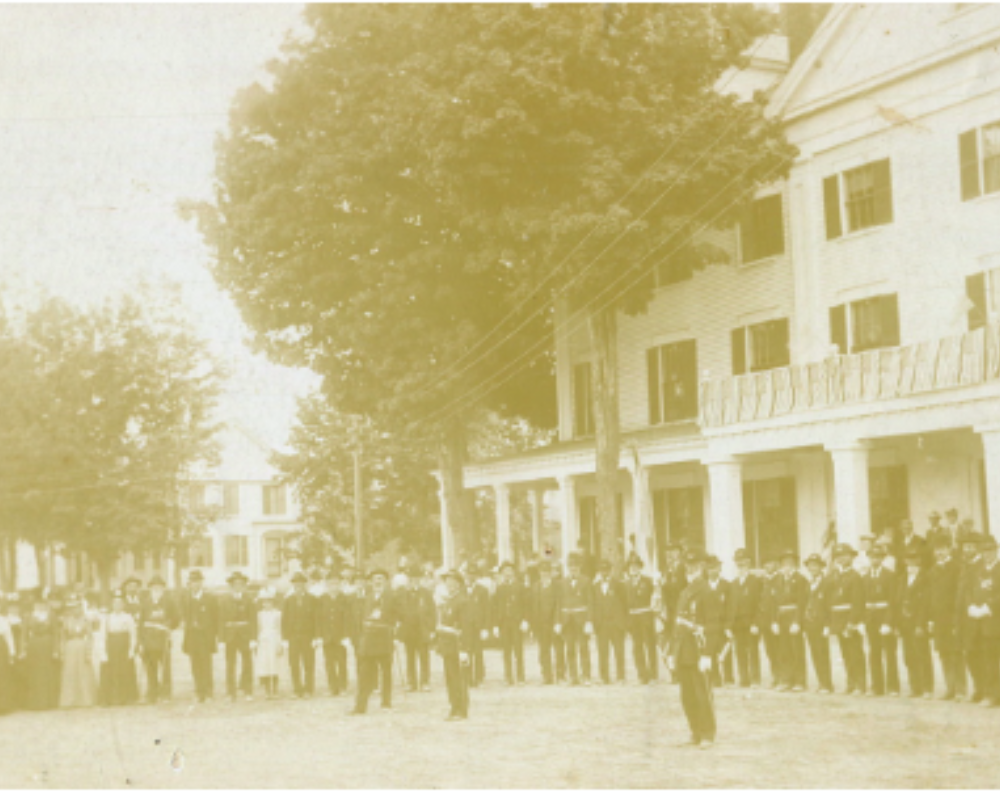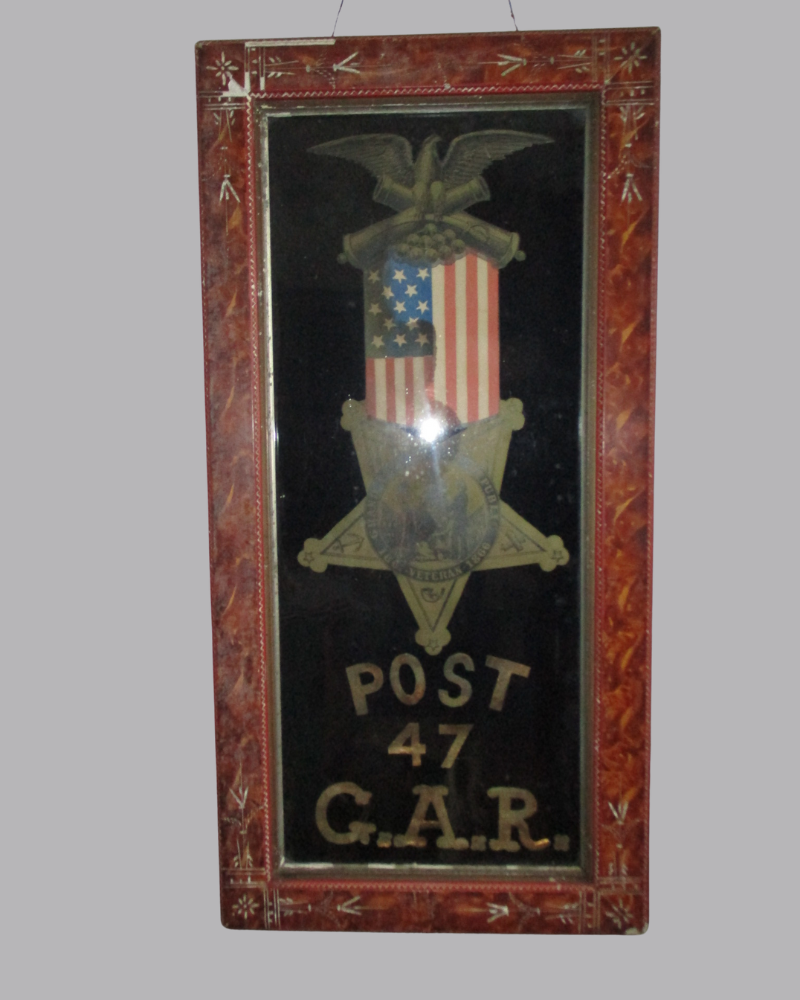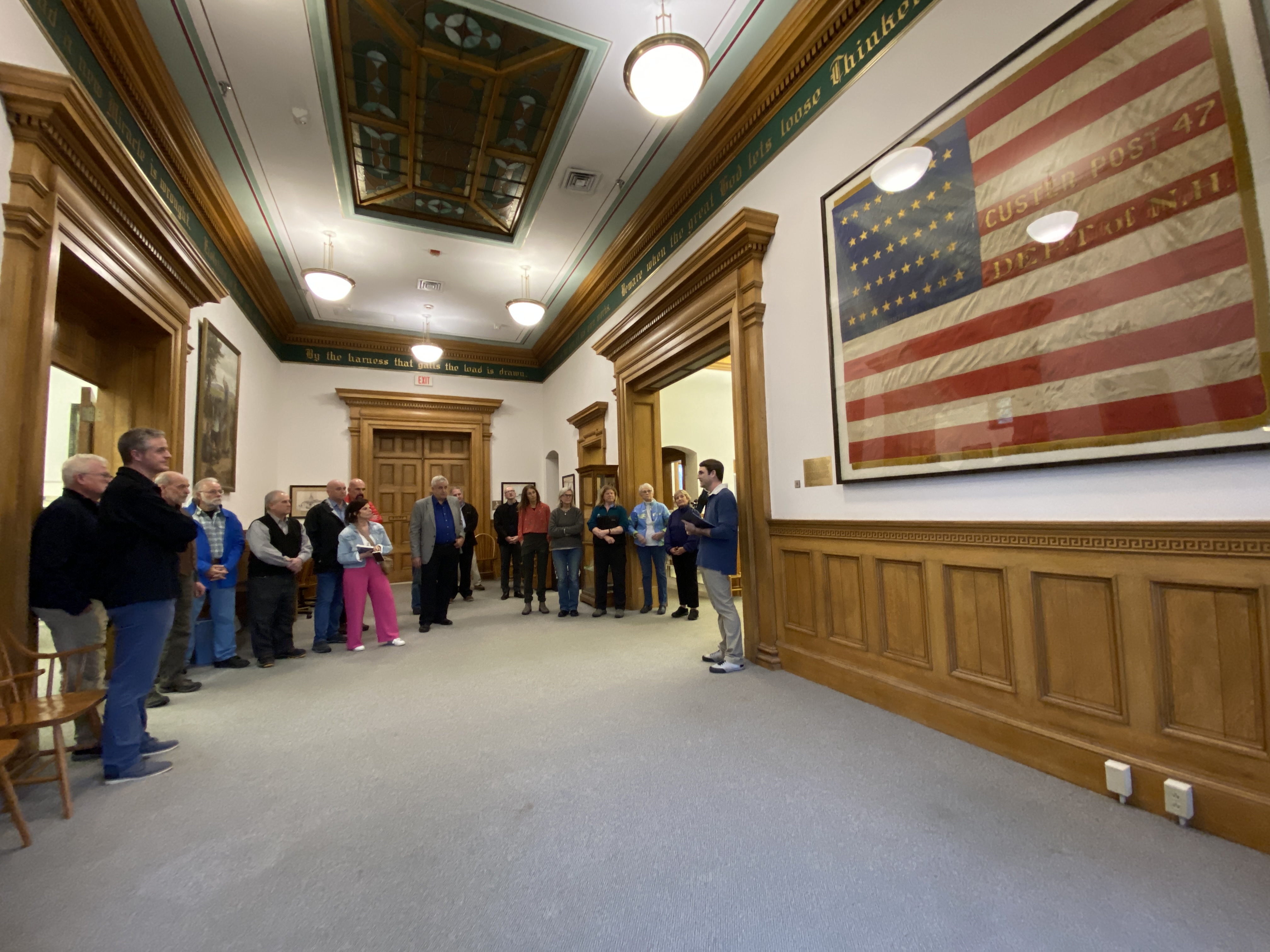CUSTER POST 47 DEP.T of N.H. Flag

In 2024, the Conway Public Library completed a multiyear cleaning and preservation project to frame the Custer Post 47 Dep.t of N.H. flag in the Great Hall of the Library, preserving a remarkable piece of community heritage that will remain viewable for future generations to learn about our shared history.
For nearly one-hundred years, the flag had been displayed hanging from its original pole at the Library in the case pictured below. Unfortunately, gravity, sunlight, and time had begun to damage the sensitive fabrics. With the support of the New Hampshire Conservation License Plate Trust Fund, the New Hampshire State Council on the Arts, and the National Endowment for the Arts, conservators from the Museum Textiles Services of Andover, Massachusetts surface cleaned, stabilized silk and fringe, and mounted the now framed flag.

This flag was used as a processional or parade flag by the Grand Army of the Republic (GAR) to honor Civil War veterans. The GAR was a fraternal organization of Civil War veterans, founded in 1866, based on the principles of “Fraternity, Charity and Loyalty.” By 1890, 409,489 members belonged to 7,000 local chapters (posts) spread across the North and West. Originally focused on promoting the spirit of self-sufficiency and independence, by the 1880s the GAR had turned its efforts towards lobbying for service pensions for Union soldiers that served any amount of time between the Attack on Fort Sumter on April 12, 1861 and the Surrender at Appomattox Court House on April 9, 1865.

Members of the Custer Post No. 47, Grand Army of the Republic, proudly carried this flag in processions, at encampments, and in Memorial Day parades every year to celebrate the service and sacrifice of soldiers in the American Civil War. The Civil War had rocked the United States of America to its core, changing the country forever. Forty men from the Conway area, veterans of service in the war, joined the ranks of the Grand Army of the Republic to form the No. 47 Post in 1879. Over the course of forty-four years, more than one-hundred Union veterans from the Conway area belonged to the No. 47 Post.

GAR posts were typically named for a famous Union general or local citizen who had died in the war. Conway’s post, chartered on September 26, 1879, was named for U.S. Army General George A. Custer (1839-1876), a dramatic and controversial cavalry commander in the American Civil War and the American Indian Wars, who had died three years prior at the Battle of Little Bighorn. At the time, Custer used print media to build a reputation as a fearless military hero. The hero’s reputation, while not univiseral in his own day, has also not survived the test of time.
Today, Custer has become a focal point for contemporary identification and criticism of long-standing American governmental policies resulting in the obliteration of Indigenous peoples and culture. The dual legacies this flag represents truly provide a tangible snapshot of American history at the time. On one hand we have a symbol of unity, healing, fraternity, and a nation trying to become whole again after being torn apart by civil war; and on the other hand we have a name that has become synonymous with acts of cultural genocide and the continued inequitable treatment of Indigenous peoples in this country.

On May 28, 1924 the Conway Public Library (then named the Jenks Memorial Library) agreed to “receive and perpetuate” this 42-star flag when it was donated by the last three surviving members of the No. 47 Post. This donation is documented in two letters written by George Staples Pitts, the commander of the No. 47 Post for the previous 18 years, to the Trustees of the Jenks Memorial Library. Pitts was unable to present the flag to the Library himself due to poor health, and soon passed away in his home on Main Street, Conway the following December.
While Pitts’ letters to the Library state that the flag was carried for all forty-four years the No. 47 Post was in existence, the physical evidence suggests otherwise. The No. 47 Post flag consists of 13 silk taffeta and canton stripes with 42 gold painted stars.
It wasn’t until November 11, 1889, a decade after the formation of the No. 47 Post, that Washington State would become the 42nd state to enter the Union. However, with Idaho officially becoming a state on July 3, 1890 and Wyoming following close behind on July 10, 1890, the 42-star flag never became an official American flag adopted by the federal government. This unique series of events gives us roughly a 243 day window, when Washington had become a state but Idaho had not, that this flag was likely sewn.

In addition to its uniqueness as a 42-star American flag, GAR flags are rare to find in good condition. For decades following the Civil War, aging soldiers would march through the streets in celebration along with their GAR flag, despite their fragility and obvious wear. Often photographs of these parades remain, but the people and flags do not. The No. 47 Post flag is a rare case in which a flag shows proof of having been on display, was known to have been hand carried in processions on a pole, and was still in good enough condition that it could be carefully handled, mounted, and framed nearly 150 years later. The Henney History Room in the Conway Public Library has a number of additional resources for those interested in learning more about honoring our country’s veterans. We have a collection of books and archives that cover all eras of American military service. Especially interesting for locals is the record book for the No. 47 Post, which lists the names of over one hundred members along with information on their age, birthplace, occupation, service records, nature of wounds received, and so on. The records in this book date from Sept 26, 1879 to 1923.
Dedication Ceremony of the No. 47 Post GAR Flag - April 12th, 2024 - photo by Kim Murdoch

Transcript: 1st Letter from the No. 47 Post to the Jenks Memorial Library
Headquarters Custer Post 47 Dept NH GAR Conway, NH
To the Trustees of Jenks Memorial Building Conway
Gentleman. The three surviving members of the Post respectfully request that they may place the flag owned and carried by the Post for the last fourty four years, in the Library Building, to be kept and preserved there for all future time.
George S. Pitts
George F. Ricker
James R. Thurston


Transcript: 2nd Letter from the No. 47 Post to the Jenks Memorial Library
Conway, May 28, 1924
To the Trustees of the Jenks Memorial Library of Conway
You have so kindly consented to the request of the three members of Custer Post, no 47 of the GAR to receive and perpetuate their flag carried by them for forty-four years.
I had hoped to present it to you personally, being the Commander of the Post and the longest in office, but sickness and infirmities of age make it impossible for me to do it.
Therefor, I delegate the President of Custer Relief Corps no 71, Dept of New Hampshire, or any whom she may direct, to perform this duty for me.
We assure you that this will be considered a great honor to the surviving families of the Post.
We know that this flag represented them at more than a hundred battle fields, in the great War of the Rebellion and we know that you will faithfully carry out our wishes and desires, also to place the Commander’s picture with the flag, according to your request.
George S. Pitts
Custer Post no 47 Dept of NH
Commander for eighteen years
Selected Sources Used in Preparation
America. Chapel Hill, North Carolina: University of North Carolina Press, 2011.
THE CONWAY DAILY SUN, Bill Marvel Article - May 22, 2020 Custer No. 47: Conway's forgotten Grand Army post | Local News | conwaydailysun.com
THE CONWAY DAILY SUN, Tuesday, June 30, 2015 on page 6 of this 2015-vintage Daily Sun - GAR post profusely, and photo of the members at the Four Corners, circa 1898. https://www.dropbox.com/sh/mznz8p3dtpv81lr/AABDD_jPviNwzdZyKkl56Bk4a/Con...
Edward Caudill and Paul Ashdown. Inventing Custer: The Making of an American Legend. Lanham, Maryland: Rowman and Littlefield, 2015.
George G. Kane, Compiler. The Grand Army of the Republic in New Hampshire. Wilton, New Hampshire: Typescript by George G. Kane, 1997. (NHHS Library)
Georgia Drew Merrill, Editor. History of Carroll County, New Hampshire, Illustrated. (Boston, Massachusetts: W. A. Ferguson & Company, 1889), 182-185.
James Donovan. A Terrible Glory: Custer and the Little Bighorn. The Last Great Battle of the American West. Boston, Massachusetts: Little Brown and Company, 2009.
James A. Marten. Sing Not War: the Lives of Union & Confederate Veterans in Gilded Age
Roxanne Dunbar-Ortiz. An Indigenous Peoples’ History of the United States. (Boston,Massachusetts: Beacon Press, 2014), 146.
Stuart McConnell. Glorious Contentment: The Grand Army of the Republic, 1865-1900. Chapel Hill, North Carolina: University of North Carolina Press, 1997.
https://en.wikipedia.org/wiki/Grand_Army_of_the_Republic Accessed November 26, 2023.
https://en.wikipedia.org/wiki/George_Armstrong_Custer Accessed November 25, 2023.

